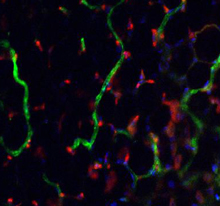Stem Cells Coaxed To Create Working Blood Vessels
Stem Cells Coaxed To Create Working Blood Vessels
Scientists directed human stem cells to form networks of tiny blood vessels that can connect to the existing circulation in mice. The finding might assist future efforts to repair and regenerate tissues and organs, which need an adequate blood supply to grow and survive.

Networks of lab-grown human blood vessels (red) become incorporated into mouse vascular networks (green). Image by Kusuma et al., courtesy of PNAS.
Some research groups are working with pluripotent stem cells, which have the potential to transform into any cell type in the body. They’ve found ways to direct the stem cells to become specific cell types, including pericytes and endothelial cells. But the process is complex, requiring multiple rounds of cell sorting and purification. Some scientists have tried growing distinct sets of precursor cells in the protein scaffolds of “decellularized” blood vessels. To date, though, many of these efforts have been inefficient and difficult to translate for clinical use.
In hopes of simplifying the process, Dr. Sharon Gerecht and her colleagues at Johns Hopkins University aimed to take advantage of the natural ability of endothelial cells to self-assemble into vascular networks. Their research was supported in part by NIH’s National Heart, Lung and Blood Institute (NHLBI) and National Cancer Institute (NCI). Their results were published in the July 30, 2013, issue of the Proceedings of the National Academy of Sciences.
The scientists first devised a way to use chemical cues to guide human pluripotent stem cells to form a specialized population made up of just 2 types of vascular cells. This bicellular population could only mature into pericytes and endothelial cells. “It makes the process quicker and more robust if you don’t have to sort through a lot of cells you don’t need to find the ones you do, or grow 2 batches of cells,” says Sravanti Kusuma, who developed the method.
The scientists next grew the bicellular population in a 3-D hydrogel matrix—a clear, mesh-like gel that mimics the environment inside the body. Within days, complex networks of hollow vascular tubes appeared, including both endothelial cells and pericytes.
To see how the cells would behave within the body, the scientists implanted the gel-encased microvascular networks into mice. By 2 weeks, the implanted cells and vessels had become connected to the mouse circulatory system and allowed blood flow. The researchers, though, note that additional studies are needed to fine-tune the process before it can be tested in humans.
“In demonstrating the ability to rebuild a microvascular bed in a clinically relevant manner, we have made an important step toward the construction of blood vessels for therapeutic use,” says Gerecht. “Our findings could yield more effective treatments for patients afflicted with burns, diabetic complications and other conditions in which vasculature function is compromised.”
By Vicki Contie
###
* The above story is reprinted from materials provided by National Institutes of Health (NIH)
** The National Institutes of Health (NIH) , a part of the U.S. Department of Health and Human Services, is the nation’s medical research agency—making important discoveries that improve health and save lives. The National Institutes of Health is made up of 27 different components called Institutes and Centers. Each has its own specific research agenda. All but three of these components receive their funding directly from Congress, and administrate their own budgets.



















